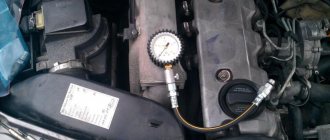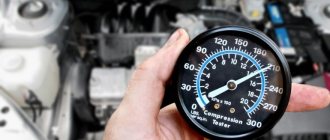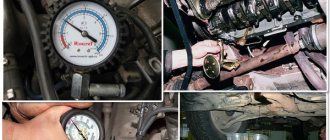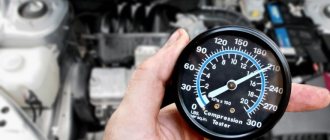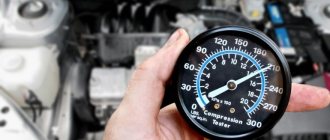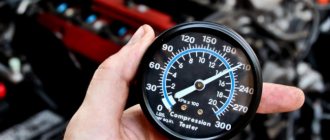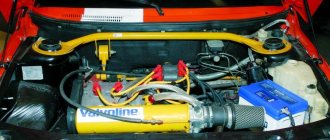VAZ 2112 engine compression, measuring pressure in engine cylinders
Compression in a VAZ 2112 engine is the most important indicator for diagnosing engine faults without disassembling. Engine compression is the pressure in its cylinders that is created at the very end of the compression stroke. When there is insufficient compression in the VAZ 21124 engine, the engine power is noticeably reduced. The difference in pressure values in each cylinder, and its average value, make it possible to determine quite accurately the level of general wear of the engine piston group, and to identify malfunctions in the piston system and in the system of valve mechanism parts.
Compression 124 VAZ engines
The VAZ 21124 engine with 16 valves appeared in 2004, by reconstructing and improving the 2112 engine and was installed on cars produced by the AVTOVAZ concern, models 2111, 2112, 2111. The
updated internal combustion engine received an increased displacement - 1.6 liters. The increased engine volume of the VAZ 21124 was achieved by increasing the distance between the axes of the main and connecting rod journals of the crankshaft by 7.3 mm (it was 30.5 mm, now it is 37.8 mm). Moreover, the increase in volume occurred without changing the diameter of the cylinders; it remained the same - 82 mm.
Thus, the designers' intention was achieved - bringing the environmental characteristics to the European level. Let's consider its description in more detail.
Set the timing marks correctly - otherwise you will bend the valves!
The VAZ-21124 engine has a special feature: no matter how its pulleys are turned, it does not bend its valves. With the 21120 engine (16v 1.5 l) such jokes will not work! If the pulley positions are not too far off, try putting on the belt and turning the mechanism to the “TDC 1 and 4” position. From now on, always use the following instructions:
- The crankshaft is set to the required position by checking the mark on the generator drive pulley (photo 1) or on the crankshaft pulley (photo 2);
Alternator drive pulley and crankshaft pulley
- Let us clarify: there should be 20 teeth between the DPKV sensor and the “pass”;
- The marks on the “upper” pulleys should point straight up (photos 3 and 4). These pulleys must be fixed, after which the tension can be released;
Exhaust and intake shaft pulley
When the belt is loose, the crankshaft cannot be rotated.
In theory, on the VAZ-2112, marking is carried out the same way, no matter what engine we are talking about. Here are photos for engine 21120.
What it looks like in reality and in the instructions
Take the time to find the inspection window on the gearbox housing. There is another mark under the plug.
The last step is optional. And they do it so as not to redo all the work “from scratch.”
- The number of belt teeth between the “upper pulley” marks is exactly 16;
- The mark on the crankshaft pulley sometimes breaks off - use the control method “1” (photo 1) or “3” (lower photo).
Updates for VAZ-21124
On a 1.6 engine, all actions are performed in the same way as described above. There is one exception - the generator drive pulley is aligned according to the mark on the casing (see photo).
Generator drive pulley, motor 21124
However, if this mark is not there, use the proven method: 20 teeth are counted from the DPKV body. Instead of the 21st there should be a “pass”.
The timing pulleys can be rotated as you like - the pistons will not touch the valves in any case. Compare what the pistons of two different engines look like and it will become clear what we are talking about.
For those who don't understand anything
The number of teeth on the crankshaft pulley is 21, on the camshaft pulleys – 42. When the crankshaft rotates 360 degrees, the camshafts rotate 180. In general, the full engine operating cycle consists of two crankshaft revolutions (720 degrees).
In theory, you can use an alternative configuration method. Let the camshaft pulley marks point straight down. Then the mark on the crankshaft pulley should face up (TDC 1 and 4).
If there is no fixing device, you can make it yourself. Even a puller for suspension springs will do (see photo).
Design features
The main part of the engine, the cylinder block (catalog number 11193-1002011), also differs in size from its predecessor. It is factory painted blue. Its height, the distance from the crankshaft axis to the upper plane, became 197.1 mm, versus 194.8 mm on the 2112 model.
The dimensions of the holes for the block head mounting bolts have changed; they are from the hoist with M10×1.25 threads. The main bearing supports on the 124th engine, from the second to the fifth, are equipped with channels designed to supply oil that cools the piston during operation.
The crankshaft installed is the same as on models 21126 and 11194, with the marking 11183 cast on the sixth counterweight. Due to the crank radius of 37.8 mm, a piston stroke of 75.6 mm was provided. A toothed pulley is installed on the shaft for timing belt drive. The belt is 25.4 mm wide and has 136 teeth, parabolic in shape. Belt service life is 45,000 km.
The pulley is designed to drive additional units using a V-belt. Three types of belts are used, differing in length, depending on the equipment:
The pulley is designed in such a way that it acts as a damper, reducing the torque loads acting on the shaft. Another function is to determine the position of the crankshaft using a sensor and a gear mounted in the damper.
The improvement affected the pistons. Their bottoms are made with valve recesses 5.53 mm deep to avoid the valves hitting the piston bottom when the timing belt breaks.
On previous VAZ 16v models without recesses or with recesses of shallower depth, in such a situation there was a risk of bending the valves, which led to expensive repairs. So, concerns and frequently arising questions about whether the valves bend on this engine have been removed.
Oil scraper and compression rings are made of steel or cast iron. The pistons and connecting rods are connected using floating pins, 22 mm in diameter, 60.5 mm in length, secured with retaining rings. The pins and connecting rods are borrowed from the VAZ 2110 modification.
The block head for the 16 valve LADA 21124 engine has an enlarged docking area for the intake manifold flange. Both camshafts for the exhaust and intake valves, as well as the valves themselves, springs, and hydraulic compensators have also been preserved from the previous modification of the engine.
In order to avoid confusion, the shafts are marked with a digital code. If it ends at 14, then this is the exhaust valve shaft, if at 15, then this is the intake shaft.
Another difference is that there is a raw strip on the intake shaft, next to the first pushrod. By adding hydraulic compensators to the design, the manufacturer eliminated the need to maintain valves in terms of adjustment. But, they are very sensitive to the cleanliness and quality of the lubricant. Low-quality oil will quickly damage parts and must be replaced; such repairs are not provided for the VAZ 124.
The spring-valve group is similar to model 2112. Valves with one spring and rods with a diameter of 7 mm (on eight-valve heads their diameter is 8 mm). Toothed pulleys with marks for setting the valve timing are installed on the camshafts. Compared to model 2112, the marks are shifted relative to each other by 2°.
Just like the shafts, the pulleys have differences in design and markings - on the inlet, a strip is welded on the back side, on the outlet it is missing. Both pulleys have markings in the form of circles on the hub.
Correct belt tension is done using support and tension rollers with flanges (to eliminate the possibility of slipping).
The cylinder head gasket is made from asbestos-free material. The holes for the cylinders are made with metal edging.
The intake manifold is combined with the receiver and is made of plastic.
For the first time in cars of the VAZ 2110 family, a catalytic converter was installed, combined with an exhaust manifold. Depending on what EURO 4 or 5 requirements the 124 motor is designed for, a different type of collector is installed.
The design of the fuel rail was updated and it began to be made from stainless steel. The drain line was removed from the fuel system; instead, a bypass valve was installed on the pump to relieve excess pressure. To supply fuel directly to the cylinders, nozzles manufactured by Bosch and Siemens were used.
The ignition coils were installed on spark plugs, each spark plug had its own individual coil, with additional fixation to the valve cover. With this method, high-voltage wires were no longer needed, and the ignition control began to be carried out by Bosch M7.9.7 or Russian January 7.2 control units, intended for EURO-4 and 3.
How to change it yourself?
Before changing the timing belt yourself, you need to study the diagram of the gas distribution mechanism, stock up on the necessary tools, and also imagine the order of work in the form of a sequence of actions.
Before replacing, study the timing diagram
There are differences between modifications of the VAZ 2112, but the basic algorithm is approximately the same for all modifications. This algorithm can also be used on VAZ cars of other modifications, for example, 2110. It is necessary to have a good manual that explains the progress of work step by step. And if you have at least a little experience in car maintenance and minor repairs, we can calmly carry out timing belt maintenance ourselves and change the necessary parts.
Tools and materials
The set of basic tools is small:
- socket heads for 10, 15 and 17;
- spanner or open-end wrench 17;
- large flat screwdriver;
- key for the tensioner pulley (if power steering is installed on the car).
The materials required are a new timing belt.
Step-by-step instruction
- The work begins by removing the negative terminal of the battery.
- Using a 10mm socket, unscrew the six bolts and remove the gas distribution mechanism cover.
- The crankshaft sensor chip is disconnected.
- The crankshaft sensor mount is unscrewed. Then you need to remove the sensor.
- The sensor hole must be aligned with the part of the pulley where there are no teeth. This is done so that the crankshaft sensor can detect TDC (top dead center). In addition, the area without teeth is used to block the pulley. After alignment, you need to put a 12mm hexagon in the hole of the sensor and fix the pulley.
- When the pulley is blocked, the generator nut is unscrewed.
- The belt tension roller bolt is loosened. After this, the belt is removed. Often during this operation the tension and support rollers and the pump are also changed.
- Installing a new timing belt. There are two ways to correctly install this part. First: put on the belt with the tension roller removed. The tension is adjusted after installing the roller. Second: install the belt by turning the exhaust camshaft pulley using a 17mm wrench.
- Next, you need to tighten the timing belt using the adjusting bolt. It rotates using a 10 key. Rotation clockwise increases the tension, counter-clockwise weakens it.
Malfunctions and repairs
The most common malfunction that VAZ 2110 owners encounter is when the 21124 engine fails. This is expressed in unstable engine operation, interruptions in operation, increased vibration, noise and gasoline consumption. What could be the reasons for this unpleasant phenomenon and what repairs will be required on the VAZ 21124 engine.
If the engine in any VAZ 2110 car is malfunctioning, then, firstly, you need to find out the reason, diagnose the ignition, fuel supply system, gas distribution mechanism, electronics and mechanical parts (pistons and crankshaft) and repair the VAZ 124, even if you do it yourself .
The 124 engine does not cause any other special problems. Previously, there was a problem with the impact of the valves on the piston and bending of the valves and the subsequent need to repair VAZ of previous modifications. But the 124th engine is freed from this problem due to recesses in the piston bottoms.
I bought a compression gauge today and decided to measure the compression. Engine 21083, 1.5 8 cl injector. All cylinders have 14.0, no oil consumption, brown carbon deposits on all spark plugs. Is this normal?
Comments 31
You have simply excellent compression, don’t sweat it and get the right amount of soot, in short, everything is clear!
A bit much. It's not that it's bad, but rather implausible. I have one like this on my 124, but I haven’t seen more than 12 on your engines. Did you measure it correctly? Turn the gas to the floor and turn it until it locks? Are you sure it doesn't burn oil? Is the engine running well overall?
Yes, the gas is to the floor, the oil does not drop a millimeter from change to change, I measured it correctly. The engine runs like a clock, pickup is good, consumption is low. Idle keeps stable at 880
What kind of compression meter is it, if it’s not a secret?
Graphs of 16 valve engines - power and torque
All engines of the “tenth hatchbacks” are ordered by power as follows: 21120, 21124, 21114 and 2111. They develop 93, 90, 81 and 77 “forces”. The graph shows how power varies with rpm.
The first two engines, 20 and 124, are 16-valve. Both belong to the Euro-3 class.
Engines 21124 of later years of production meet Euro-4 standards. They have an improved catalyst installed. The ECU unit was also installed differently, updated.
124 engine under the hood of the “two-wheeler”
The pistons of the 124 series engines have grooves for the valves. Simply put, the internal combustion engine of the VAZ-21120 is plug-in (valve bending as a result of a broken timing belt, the valves will need to be replaced, and then it depends), and 21124 is not plug-in (does not bend the valve). Let's estimate the torque.
The most interesting thing here is the VAZ-21120 engine. In terms of “low-end traction” it is not much inferior to 8-valve engines.
Formal characteristics
Here are the characteristics of two different motors:
The lower the compression ratio, the more “omnivorous” the engine will be in relation to fuel.
What cars was it used in?
During production, engine 21124 was installed and continues to be used in VAZ models:
- 21104 (“ten”) – four-door sedan;
- 21114 (“eleventh”) – five-door station wagon;
- 21124 (“twelfth”) – five-door hatchback;
- 21123 (Lada 112 Coupe) – three-door hatchback;
- 211440 (“fourteenth”) – five-door hatchback.
Lada 112 Coupe
Starting from the “fifteenth” VAZ model, the 21124 engine was no longer used, a more powerful version 21126 and the next generation internal combustion engine were installed. However, the characteristics of the engine allow for independent tuning to increase power and throttle response.
Some conclusions
The steel receiver looks powerful and beautiful
All VAZ-2112 hatchback engines differ in characteristics, and the differences are significant. It seems that the best option would be a 16-valve 1.5-liter engine. But the 21124 (1.6) engine has its advantages:
Any 21124 engine can be converted to Euro-4 or meets these standards immediately.
The appearance of the 1.5 liter engine inspires respect. But if you remember about bending the valves, the choice becomes difficult to make. A steel receiver and a beautiful schedule are not everything.
Various nuances
Motor 21124 is more modern than its brother. It has spark plugs with individual coils installed on it. Experienced craftsmen also know about the tuning possibilities specific to the 21120 engine (for example, installing a turbine). In defense of the latter, we can say the following: the service life of the two engines under consideration is approximately the same. After the first 120 thousand, the 20th engine deserves a rating of “4.5 out of 5”.
On the secondary market, VAZ-21120 and 21126 (Priora) engines are valued almost equally. But the VAZ-21124 unit is in short supply. Draw conclusions.
What is oil used for?
The oil pressure indicator lights up on the instrument panel.
Automotive oil plays many functions in a car. Initially, this is the lubrication of parts and internal elements. So, without this, rapid wear of most spare parts is inevitable. The second function is cooling the motor elements. Oil is a good “heat absorber”, which provides additional protection against overheating.
The third function is to provide compression. This indicator gives traction power and normal functioning of the engine, namely operation at idle and at higher speeds.
What builds up oil pressure
To pump oil, the engine has an oil pump, which lifts oil from the sump and distributes it throughout the entire system. Thus, it not only provides lubricant, but also creates the necessary pressure. There are several factors that can cause the pressure in a car to drop:
- Unstable timing.
- Oil pump failure.
- Valves not fully closed.
- Other factors that can lead to loss of engine pressure.
What should the pressure be?
Now, directly to the question, what should be the pressure in the 16-valve VAZ 2112 engine? If you believe the manufacturer’s data, then the engine when measuring the pressure gauge should produce the following indicators:
- At idle speed - 2-2.2 bar .
- At speeds of 4-5 thousand - 5-6.5 bar .
The pressure gauge measures the oil pressure in the engine
As practice shows, most motorists have the following indications:
- At idle speed - 1.5-2 bar .
- At speeds of 4-5 thousand - 4-6 bar .
This indicator is considered normal for the complete and uninterrupted functioning of the engine, as well as ensuring the normal operation of all systems.
VAZ 2112: engine compression - check and increase
For some reason, many car owners confuse concepts such as compression and compression ratio. However, despite their similarity, they are not one and the same. This is approximately the same as the angle of the closed state of the contacts and the ignition timing angle. It is enough to note that the compression ratio is a geometric value, expressed in absolute units (in other words, it is simply data that is not measured in any units), they are virtually unchanged for engines of the same model, if they have not been modified, but are in the standard configuration . Compression, in turn, is measured in pressure units (bar, MPa, atmospheres), its readings are very dependent on the measurement method and the technical condition of the car. At the moment we will tell you about what the compression of the VAZ 2110 engine is.
Compression is a physical quantity that determines the pressure that is created in the cylinder at the end of the compression stroke. It is measured in kg/cm2 or atmospheres; less often you can find measurements in kilopascals, bars and other units. As wear occurs, compression can vary greatly. It may depend on the compression ratio (good engine compression can be considered to be approximately the calculated value by multiplying the compression ratio by 1.5 atm - this is due to the effect of adiabatic compression). As a result, the corresponding compression values for a standard VAZ 2110 engine will be approximately 7-9 atmospheres. (If the engine is forced, the compression may change to 11-13 atm.).
The meaning of compression is the technical condition of the engine and the entire machine as a whole, along with oil pressure. The higher the compression level, the fewer gases will break into the engine crankcase and, as follows, more gases will do useful work, and at the same time the power will also increase. Oil consumption, throttle response, engine stability, engine start-up speed, fuel consumption will all depend on the compression level. In addition to all this, the compression value can be affected by the state of the electrical equipment (battery, starter, connecting wires) when measuring it.
When compression drops in any of the VAZ 2110 cylinders (maybe this happens in all cylinders at once) or compression levels are different in all cylinders, the engine will need to be repaired. Often the main reason for a drop in compression is worn out piston rings, for example, after overheating. In second place are valves. Then a breakdown of the cylinder head gasket. There may also be exotic conditions, such as a piston pin that has come out, or a burnt piston that has “milled” the liner. In order to find the cause of the drop and imbalance of compression, oil is poured into the cylinder, after which the compression is determined again. If at the same time it increases significantly, then the rings are almost always to blame. If not, the problem is most likely in the valves or head.
The main significant problems that low compression causes are a drop in power, a decrease in top speed, deterioration in acceleration dynamics, and an increase in the amount of fuel and oil absorbed - sometimes this is very noticeable.
To measure the compression of a VAZ 2110 you need to use a special device - a compression meter, which looks like an ordinary pressure gauge, with which the tire pressure will be measured. This device has a special adapter that needs to be screwed into the candles, or simply pressed tightly against the hole with a rubber ring. The adapter has a nipple or spool that allows you to save the instrument readings for comfortable reading. Such compression meters can be purchased at any auto market.
Compression is often determined in two ways: advanced - with closed valves in the carburetor, very ordinary - with open valves. To obtain clearer results, professional mechanics measure compression using 2 proposed methods. At the same time, they do not even unscrew the spark plugs in other cylinders, taking measurements on a cool engine, with the carburetor valves open or closed. Any of the methods gives its results and helps to find flaws more accurately.
Repair
As I wrote above, it’s really difficult to make repairs yourself. Unless, of course, you have a blown gasket, it’s possible to repair it, but again, it’s not so easy. How to replace a short video.
Diagnostics are carried out with the cylinder head removed - here the malfunction can be determined 100%. You are unlikely to do it yourself; contact specialists at a service station, or people who understand.
You can diagnose the parts of the power unit without disassembling it. For correct diagnosis, you need to know what compression should be in 2110. The article contains information on methods for measuring compression and detailed instructions with a video test of a 16-valve engine.
Why is verification needed?
After long-term operation, the 16-valve VAZ 2110 engine begins to operate unevenly, smoke, and fuel and oil consumption increases. The cause of such problems may be significant wear of the connecting rod and piston group. To find out, it is not necessary to completely disassemble the engine; it is enough to measure the pressure in its cylinders depending on what compression it is to draw conclusions about the serviceability of the components.
The pressure in the cylinders may decrease for the following reasons:
What is the standard compression for a VAZ 2110 with 16 valves can be calculated using the following formula:
Compression = compression ratio * K factor
The compression ratio is indicated in the vehicle's owner's manual and is different for each model. The K coefficient depends on the type of engine: for a gasoline engine it is 1.2, for a diesel engine it is 1.8. Experienced drivers do not need calculations, since they know from their experience what compression should be on their car.
You should regularly measure the compression in the cylinders in order to diagnose and eliminate problems in a timely manner without bringing the engine to overhaul. Measurements are taken with the carburetor flaps open and closed.
An open damper makes it possible to detect the following problems:
When the damper is closed, you can determine:
Reasons for low compression
The cause of weak engine compression can be determined by supplying compressed air to the cylinder:
- The piston in the cylinder is initially brought to (TDC) during the compression stroke
- To supply air to the combustion chamber, remove the conical rubber tip from the compression gauge and connect the hose from the compressor to it.
- Unscrew the spark plug and insert the tip into the hole, then supply air under a pressure of about 0.2–0.3 MPa into the cylinder
- To prevent the engine crankshaft from turning, engage the gear and stop the car using the parking brake.
- After this, you can determine the cause of low compression
- When air leaks through the throttle body, it indicates a broken intake valve seal.
- When air is forced through the muffler, the exhaust valve is not sealing properly.
- When your cylinder head gasket is damaged, then air escapes through the neck of your expansion tank and bubbles appear in it.
- A leak into an adjacent cylinder is diagnosed by the hissing sound characteristic of this process.
How to check compression in a VAZ 2110 engine? (Video)
Compression is the pressure in the engine cylinders that is created at the end of the compression stroke. If the compression is too high, the concentration of the air-fuel mixture will be high, causing rapid ignition and explosions. As a result, the engine will begin to collapse. Low compression reduces engine power, dynamics decrease, and it is not possible to reach maximum speed. Plus, fuel and oil consumption increases noticeably.
At low pressure (compression), the air-fuel mixture ignites slowly, causing the engine to heat up. Destructive consequences are inevitable if the problem is not addressed.
Standard pressure gauge for testing
We do a check for a 16-valve car
To carry out a compression test on a 16-valve VAZ 2110 engine, it is better to invite an assistant and prepare the following tools:
When choosing a device, you should pay attention to its limit switch, which is used to connect to the engine. It can be threaded or rubber. It is better to choose one with threads, this will make the work easier.
Many VAZ-2110 owners wonder why their cars have different compression? Typically, compression is injected as the piston moves from the bottom to the top. In this case, a certain pressure is created in the cylinder. Good compression can only happen if all gaskets, pistons, rings or valves are in good condition. It is because of these elements that the air in the system is compressed.
Normal compression on a VAZ-2110
Typically, compression is checked using a special device. It is recommended to do this regularly.
This helps determine the degree of wear of the motor and rings, as well as the piston itself. Normal cylinder pressure on a VAZ-2110 with 8 valves should be from 10 to 12 atmospheres
Normal compression in the cylinder.
It is also worth noting that sometimes the pressure in different cylinders may differ
. If it is 0.5-0.7 atmospheres
, then this phenomenon is normal and should not cause concern.
Abnormal compression
This happens when there are more or less atmospheres in the cylinder than in others.
Such an engine will not be able to operate normally. He absolutely needs to carry out repairs.
Causes
Burnout of the gasket between the block and the head is a fairly common defect.
There can be many reasons why there may be a difference in compression. Experts highlight the main ones. This:
A little about the throttle valve design
- The car needs a throttle valve to restrict the incoming air.
- It is installed after the air filter in front of the intake manifold.
- The throttle valve is controlled by the gas pedal, that is, you press the pedal and the throttle valve, meanwhile, introduces air into the engine.
- There are also sensors on the throttle valve that regulate the valve itself and this is a separate part that is attached to the throttle.
- The throttle valve tends to become contaminated, partly by exhaust gases, and partly by crankcase gases.
Due to contamination, the damper stops opening completely or gets stuck. Cleaning the throttle body can help prevent this; there are many cleaning products that can help you.
Checking engine compression on a VAZ 2109
If blue smoke comes out of the exhaust pipe of a VAZ 2109, this is most likely due to wear on the piston rings, but for this it is necessary to measure the compression in the engine cylinders. We will check the engine compression on a VAZ 2109. For this you do not need special equipment, only a compressor is useful.
So, we start the VAZ 2109 and warm it up to operating temperature, which is about 80-90 degrees. You also need to check the valve clearances, they should be the same, so if they are not, then you will need to adjust them. Next, unscrew the spark plugs using a special key, there are 4 of them on the VAZ 2109, then open the throttle and air damper. Take the compressor and insert its end into the spark plug slot. Now you need to use the starter. Since the spark plugs are removed, the car will not start, there will only be a characteristic sound. She won't be able to do this kind of work alone, so a helper will be helpful. While one person turns the ignition switch, another monitors the compressor sensor readings. Attention, the measuring device must be held by hand, otherwise it may fly out under air pressure. Stop turning the engine when the pressure stops increasing. To achieve correct readings, it is necessary to ensure that the crankshaft rotates in the range from 180 to 350 rpm. During the inspection, make sure the car battery is charged.
If you connect another power source to the starter terminals, you may overvoltage for a while. Write down the highest indicator value on a piece of paper, and then reset the arrow to zero. The same operation must be done with the remaining three cylinders. Remember that the minimum permissible compression ratio in the cylinders must be at least 10 kg/sq.m. See, and the difference between the cylinders should not exceed 1 kg / sq. See: If one cylinder has less compression than the other, the problem is a leaky valve seat, worn compression rings, or a damaged cylinder block gasket. If measurements show a low level of compression in all rings, then this is wear on the piston rings. To more accurately determine low compression in one cylinder, you will need to pour 20-25 cc directly into the spark plug hole. See the engine oil and measure the compression ratio again. Does the sensor show the same numbers? Thus, the valves release pressure from the seats or the cylinder block gasket is worn out. At high compression, when the oil level rises, this is wear on the piston rings. The cause of low compression can be checked in another way. It is necessary to fix the piston at the top point of the compression stroke and pass air under a pressure of 2-3 kg/sq.m. See This air is forced through the spark plug hole. There is no need to allow the crankshaft to rotate the engine, so set the gearbox to a lower gear. If air passes through the carburetor, the intake valve is reduced, if the exhaust valve is reduced through the muffler. If the cylinder head gasket is worn, air bubbles will form in the radiator or other valve and a hissing sound will occur.
Due to the fact that more than 4 million units of VAZ 2106 models were produced, there are still quite a lot of them on our roads. Accordingly, the renovation of the legendary “classics” is still relevant. For example, the question of how much compression a running Six engine should maintain.
READ How to Call Alternator VAZ 2110
Reasons for low compression
The cause of weak engine compression can be determined by supplying compressed air to the cylinder:
- The piston in the cylinder is initially brought to (TDC) during the compression stroke
- To supply air to the combustion chamber, remove the conical rubber tip from the compression gauge and connect the hose from the compressor to it.
- Unscrew the spark plug and insert the tip into the hole, then supply air under a pressure of about 0.2–0.3 MPa into the cylinder
- To prevent the engine crankshaft from turning, engage the gear and stop the car using the parking brake.
- After this, you can determine the cause of low compression
- When air leaks through the throttle body, it indicates a broken intake valve seal.
- When air is forced through the muffler, the exhaust valve is not sealing properly.
- When your cylinder head gasket is damaged, then air escapes through the neck of your expansion tank and bubbles appear in it.
- A leak into an adjacent cylinder is diagnosed by the hissing sound characteristic of this process.
A popular way to eliminate stuck rings and increase compression
This method does not guarantee that the compression meter readings will change. But, it is actually effective if different compression in the cylinders was formed precisely because of the position of the rings. At a minimum, your conscience will be clear, and you will then exclude this item from the diagnosis.
If in one of the “pots” the pressure is significantly lower than in the others (for example, everywhere is 11.5, and in the only one 6.0 atmospheres), this indicates a difference in compression. Naturally, this negatively affects the operation of the power unit. Often a drop in compression can be observed in several “pots”. However, in this case, we can safely say that the engine needs urgent overhaul. There can be many reasons for a drop in compression; elimination requires dismantling the cylinder head. Here are the main reasons: 1. Broken (burnt-out) cylinder head gasket. One of the most common causes is “treated” by replacing this element. 2. The cylinder head is not tightened enough. Actually, the above reason follows from this: the gasket begins to leak pressure and eventually breaks through. 3. Rings are skipped. This phenomenon occurs if the o-rings are severely worn or broken. If the pressure drops in one “pot”, the rings are guaranteed to be broken. In this case, a major overhaul of the engine is required. 4. Coking. The rings become coated with coke due to the use of low-quality motor oil or due to high mileage. The oil burns out and the rings stick in one place, unable to move along their grooves. Only one side is ground down, which means the engine wears out faster. Coking is indicated by a drop in compression in all cylinders. 5. Wear of the walls of the cylinder block. This is a rare phenomenon and most often occurs due to the manufacturer using low-quality materials. 6. Engine overheating. If the engine overheats, the rings and the walls of the block begin to leak pressure, and with it the oil. Partially can be identified by the bluish smoke from the exhaust pipe. 7. Piston burnout. If the piston is broken, the compression in the cylinders will be virtually zero. It can burn out from both the top and the side. Often, pistons break when the timing belt breaks when, due to a violation of the valve timing, they meet the valves. 8. Valves. Compression may drop due to improper adjustment, burnout or breakage when the timing belt breaks.

